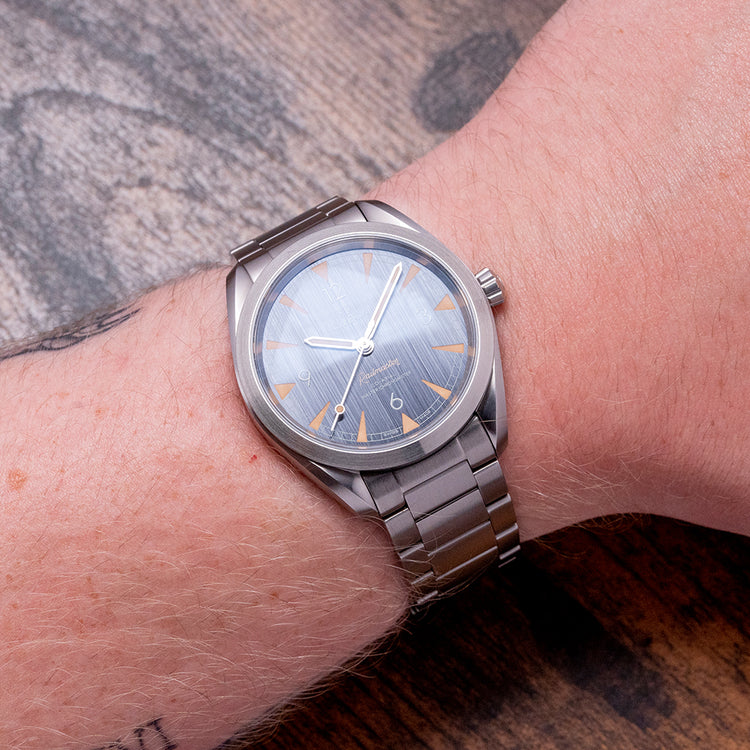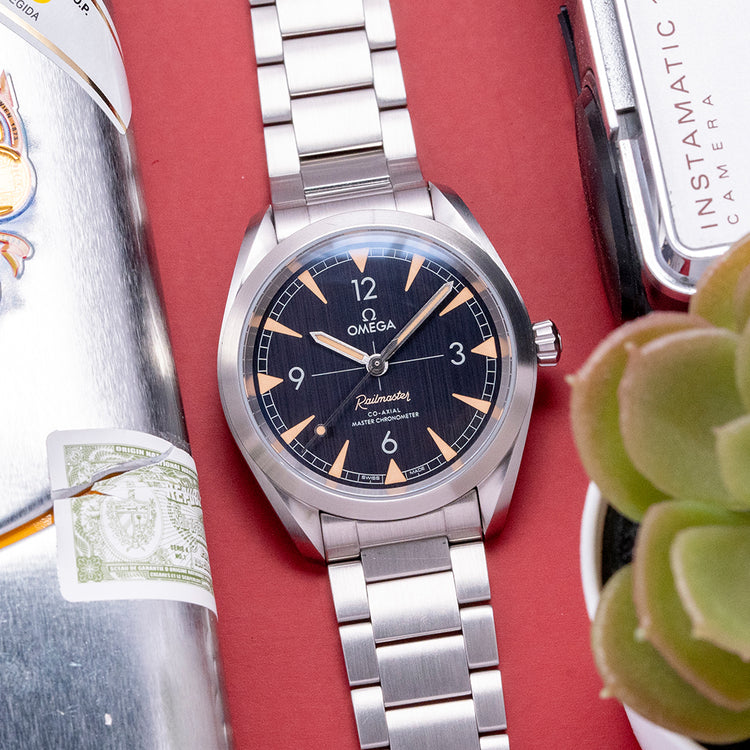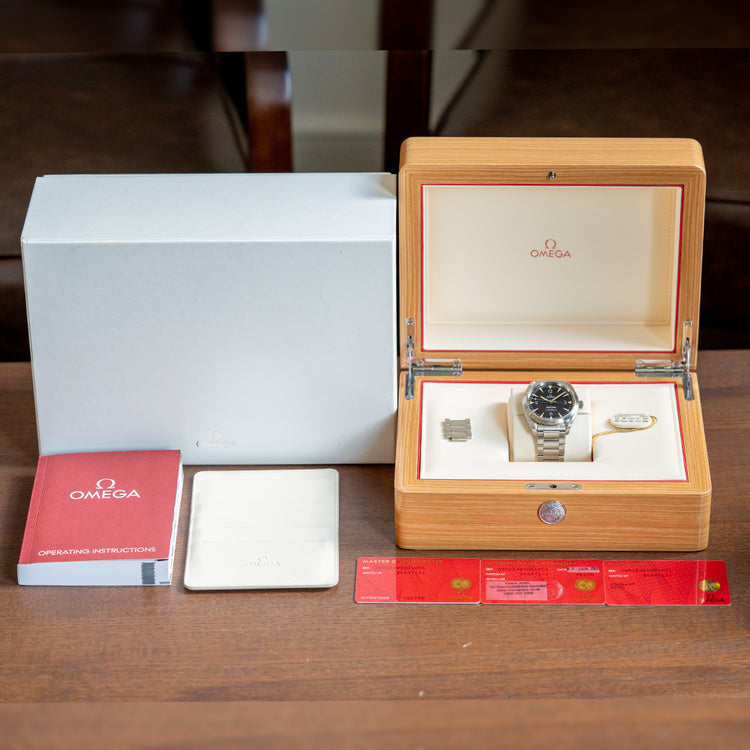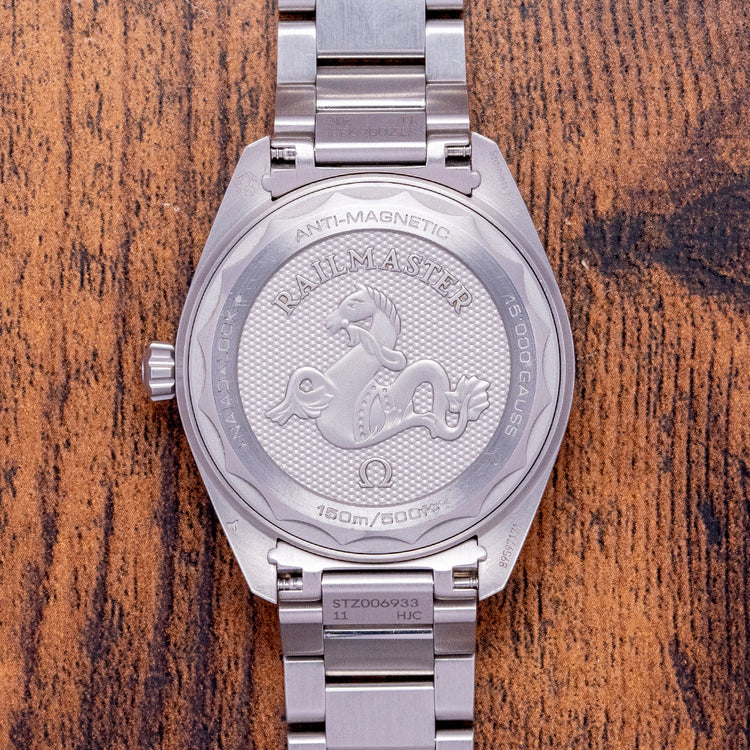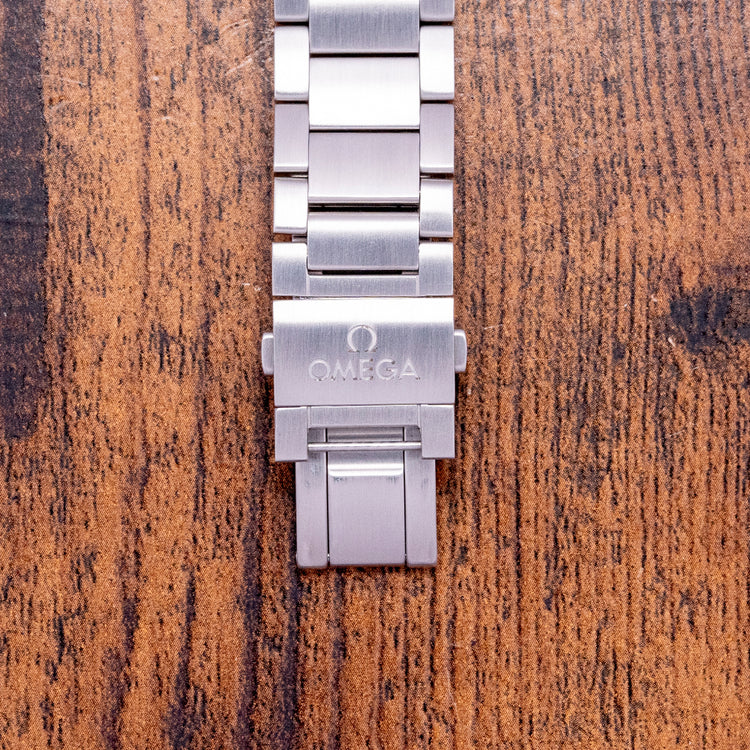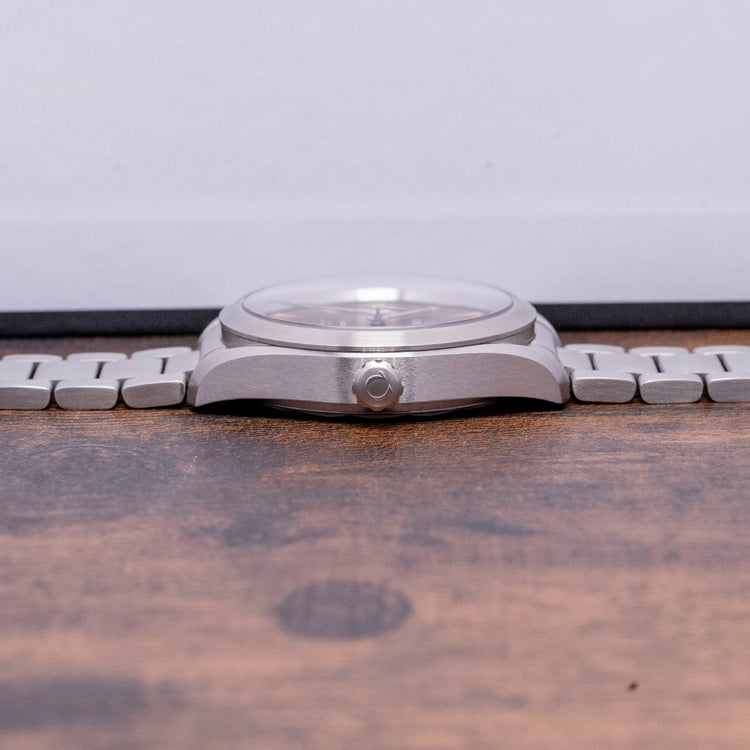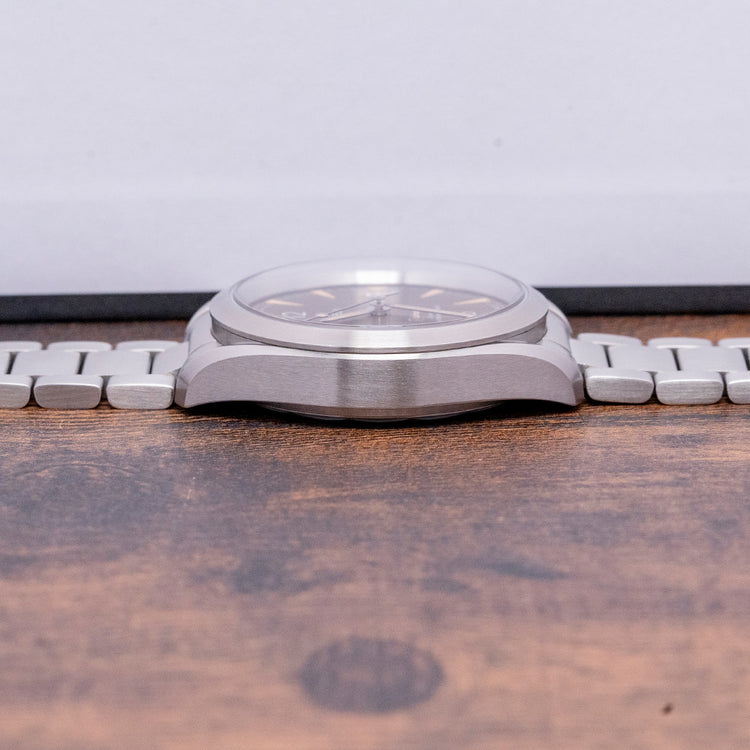More Information
Description
More
Less
The Watch
Here we have a 2020 Omega Seamaster Railmaster Co-Axial 220.10.40.20.01.001, a modern interpretation of the 1957 Omega Railmaster reference CK2914; the purpose of the Railmaster was to achieve accurate timekeeping while working near strong magnetic fields. The 1957 original had shielding that protected the movement up to 1000 gauss; this modern interpretation shields the movement up to 15,000 gausses; researchers and electrical workers working with laboratory spectrometers and electrical transformers have been working closely with Omega to produce these timepieces. The symmetrical 40mm brushed stainless steel case curves with the characteristic twisted lugs over your wrist, a lug-to-lug length of 47mm, and a case thickness of 13mm give the watch an impressive wrist presence. On the right side is a signed screw-down crown with deep knurling for extra grip. The smooth brushed stepped bezel holds a domed scratch-resistant sapphire crystal AR coated on both sides above a striking black vertically brushed dial that magically catches the light as you rotate your wrist. An outer minute track is precisely executed with the hour markers made up of recessed dagger indexes filled with a faux patina SuperLumiNova, a crosshair has the 12, 3, 6 and 9 Arabic numerals, perfectly balancing this vintage-inspired dial. Slender baton steel hands are infilled with the same faux patina SuperLumiNova and complemented by a sweeping lollipop counterweighted second-hand. At 12 o’clock, we have the Omega motif. At 6 o’clock, we have the “Railmaster” Co-Axial Master Chronometer”. On the reverse, a waffle texture has the Hippocampus and “Railmaster” embossed onto the surface, indicating its Seamaster, Speedmaster, family DNA. The screw-down case back uses the innovative Naiad locking system, the system is patented, and the patent roughly states it's a locking system designed for a screw-down case back that allows the user to orient engravings in proper alignment without matching a given case back to a given case. “Naiad” is Greek for mythical water spirits. Their soft-iron inner case protects the movement and acts as a Faraday cage. Inside an automatic Omega Cal. 8806, 35 jewels, 25,200 beats per hour, Omega uses modern materials to achieve accuracy and reliability, such as a silicon hairspring and a Free sprung balance wheel, resistant to magnetic fields reaching 15,000 gausses; the Rotor is Rhodium plated and is bidirectional for improved efficiency, certified Master Chronometer, approved by METAS, ”Swiss National Metrology Institute”, the watch goes through COSC certification before being selected for the eight tests run by METAS. The watch comes fitted on its Omega 20mm brushed stainless steel bracelet; all links are provided, a push-button butterfly clasp has a large Omega motif with fine brushing, and the watch also comes with its Omega presentation box, swing tag and papers.
Points of Mention
This watch is sold with its original Omega box, swing tag, and paperwork. It comes paired with its original 20mm brushed Omega stainless steel bracelet with all links provided, a push-button butterfly clasp with a large Omega motif and fine brushing. The watch is from January 2020 and is sold in worn, but fair condition for its age, as you can see from the photographs. The watch comes with our 12-Months Warranty.
For more photos see here - https://drive.google.com/drive/folders/1LZ5OzNNJiPogRa0izpx1ez6XnmAkrJbF?usp=drive_link
4K YouTube video, skip to 15:28 - https://youtu.be/lu3uVw5FYtk
Personal Note
The Railmaster is often overlooked in the lineup of watches on offer from Omega, and this is a real shame as it offers incredible value for money, especially on the secondary market like this one. The dials are something to admire in person, this reference 220.10.40.20.01.001 features the most impossible-to-capture, yet most dynamic dial I have seen in a while on a watch. I would not hesitate to book an appointment to come and try this one on for yourself and see that dial play in the light!
Specification
Lugs : 20mm
Condition : Pre-Owned
Box & Papers : Box & Papers
Case Material : Stainless Steel
Warranty : 12-Months Warranty
The Brand
Formerly known as the La Generale Watch Co. in 1848, it was founded by Louis Brandt in La Chaux-de-Fonds. When he died in 1879, his sons carried on his dream. In 1880, they moved to 96 Rue Jakob-Stampfli, where they remain today. The brothers produced their first mass-produced calibre, the Labrador In 1885. Just a few years later, in 1892, they produced the first minute-repeater. In 1903, they renamed the company Omega until 1982, when they officially changed their name to Omega SA. During WW1, Omega watches were used as official timekeepers for the Royal Flying Corps and the US Army. In 1930, Omega and Tissot merged together to form Société Suisse pour l'Industrie Horlogère (SSIH) In 1931, another group was formed - Allgemeine Schweizerische Uhrenindustrie AG (ASUAG). Where SSIH was primarily French-speaking, ASUAG was founded by the more German-speaking members of the Swiss watch industry. In 1948, they introduced the first edition of one of its most symbolic watches: the Seamaster. Omega first introduced the Constellation in 1952. At the time, it was Omega's flagship timepiece. The first models had a Cal. 354 bumper movement in them. Later, in 1955, Omega introduced the Automatic Cal. 50x, followed in 1959 by the Cal.55x (no date) and 56x (date) versions. Many of the Constellations came with pie-pan dials, diamond indexes, and fancy lug configurations. All the gold Constellations of that time have the Observatory of Geneva's hand engraved on the back. The stainless steel and stainless steel/gold versions had a gold medallion on the back with the Observatory of Geneva. The eight stars above the Observatory stand for the many exploits of Omega in the world Chronometer competition. It was celebrating the fact that all Constellations are Chronometer Certified. In 1962, astronaut Wally Schirra wore a Speedmaster on his Mercury Sigma 7 Mission, making it the first Omega watch to enter space. After rigorous tests, NASA used Omega for all their Apollo missions, including the 1969 Moon landing of Apollo 11. Today, Omega is still the first choice of astronauts. In 1969, President Nixon famously said it was “too valuable” and turned down the first-ever all-gold Speedmaster Professional Deluxe. As a response to the ever-growing threat of electronic watches to the manufacturers of mechanical watches, Omega and many Swiss brands such as Rolex and Patek Philippe formed Centre Electronique Horologer (CEH). Prototypes began to appear in 1967, and their production started in 1968. Then, In 1972, Omega introduced the reference 198.030, which included the Omega calibre 1250, a ‘tuning-fork electronic movement which was made under licence from Bulova. Later we saw a merger of SSIH and ASUAG into SMH, or Société de Microélectronique et d’Horlogerie. This merger took place in 1983. In 1992, the company acquired Blancpain, and in 1998, it officially rebranded itself from SMH to the Swatch Group. Then, in 1999, they purchased and integrated Breguet into the Swatch Group.
Points of Mention
More
Less
Personal Note
More
Less
Specification
More
Less
Movement : Automatic Omega Cal. 8806
Age : January 2020
Year : 2020
Case Size : 40mm
Case Thickness : 13mm
Lug to Lug : 47mm
Lugs : 20mm
Condition : Pre-Owned
Case Material : Stainless Steel
Warranty : 12-Months Warranty
The wrist model's wrist size is 7inch
About Omega
More
Less
Description
The Watch
Here we have a 2020 Omega Seamaster Railmaster Co-Axial 220.10.40.20.01.001, a modern interpretation of the 1957 Omega Railmaster reference CK2914; the purpose of the Railmaster was to achieve accurate timekeeping while working near strong magnetic fields. The 1957 original had shielding that protected the movement up to 1000 gauss; this modern interpretation shields the movement up to 15,000 gausses; researchers and electrical workers working with laboratory spectrometers and electrical transformers have been working closely with Omega to produce these timepieces. The symmetrical 40mm brushed stainless steel case curves with the characteristic twisted lugs over your wrist, a lug-to-lug length of 47mm, and a case thickness of 13mm give the watch an impressive wrist presence. On the right side is a signed screw-down crown with deep knurling for extra grip. The smooth brushed stepped bezel holds a domed scratch-resistant sapphire crystal AR coated on both sides above a striking black vertically brushed dial that magically catches the light as you rotate your wrist. An outer minute track is precisely executed with the hour markers made up of recessed dagger indexes filled with a faux patina SuperLumiNova, a crosshair has the 12, 3, 6 and 9 Arabic numerals, perfectly balancing this vintage-inspired dial. Slender baton steel hands are infilled with the same faux patina SuperLumiNova and complemented by a sweeping lollipop counterweighted second-hand. At 12 o’clock, we have the Omega motif. At 6 o’clock, we have the “Railmaster” Co-Axial Master Chronometer”. On the reverse, a waffle texture has the Hippocampus and “Railmaster” embossed onto the surface, indicating its Seamaster, Speedmaster, family DNA. The screw-down case back uses the innovative Naiad locking system, the system is patented, and the patent roughly states it's a locking system designed for a screw-down case back that allows the user to orient engravings in proper alignment without matching a given case back to a given case. “Naiad” is Greek for mythical water spirits. Their soft-iron inner case protects the movement and acts as a Faraday cage. Inside an automatic Omega Cal. 8806, 35 jewels, 25,200 beats per hour, Omega uses modern materials to achieve accuracy and reliability, such as a silicon hairspring and a Free sprung balance wheel, resistant to magnetic fields reaching 15,000 gausses; the Rotor is Rhodium plated and is bidirectional for improved efficiency, certified Master Chronometer, approved by METAS, ”Swiss National Metrology Institute”, the watch goes through COSC certification before being selected for the eight tests run by METAS. The watch comes fitted on its Omega 20mm brushed stainless steel bracelet; all links are provided, a push-button butterfly clasp has a large Omega motif with fine brushing, and the watch also comes with its Omega presentation box, swing tag and papers.
Points of Mention
This watch is sold with its original Omega box, swing tag, and paperwork. It comes paired with its original 20mm brushed Omega stainless steel bracelet with all links provided, a push-button butterfly clasp with a large Omega motif and fine brushing. The watch is from January 2020 and is sold in worn, but fair condition for its age, as you can see from the photographs. The watch comes with our 12-Months Warranty.
For more photos see here - https://drive.google.com/drive/folders/1LZ5OzNNJiPogRa0izpx1ez6XnmAkrJbF?usp=drive_link
4K YouTube video, skip to 15:28 - https://youtu.be/lu3uVw5FYtk
Personal Note
The Railmaster is often overlooked in the lineup of watches on offer from Omega, and this is a real shame as it offers incredible value for money, especially on the secondary market like this one. The dials are something to admire in person, this reference 220.10.40.20.01.001 features the most impossible-to-capture, yet most dynamic dial I have seen in a while on a watch. I would not hesitate to book an appointment to come and try this one on for yourself and see that dial play in the light!
Specification
Lugs : 20mm
Condition : Pre-Owned
Box & Papers : Box & Papers
Case Material : Stainless Steel
Warranty : 12-Months Warranty
The Brand
Formerly known as the La Generale Watch Co. in 1848, it was founded by Louis Brandt in La Chaux-de-Fonds. When he died in 1879, his sons carried on his dream. In 1880, they moved to 96 Rue Jakob-Stampfli, where they remain today. The brothers produced their first mass-produced calibre, the Labrador In 1885. Just a few years later, in 1892, they produced the first minute-repeater. In 1903, they renamed the company Omega until 1982, when they officially changed their name to Omega SA. During WW1, Omega watches were used as official timekeepers for the Royal Flying Corps and the US Army. In 1930, Omega and Tissot merged together to form Société Suisse pour l'Industrie Horlogère (SSIH) In 1931, another group was formed - Allgemeine Schweizerische Uhrenindustrie AG (ASUAG). Where SSIH was primarily French-speaking, ASUAG was founded by the more German-speaking members of the Swiss watch industry. In 1948, they introduced the first edition of one of its most symbolic watches: the Seamaster. Omega first introduced the Constellation in 1952. At the time, it was Omega's flagship timepiece. The first models had a Cal. 354 bumper movement in them. Later, in 1955, Omega introduced the Automatic Cal. 50x, followed in 1959 by the Cal.55x (no date) and 56x (date) versions. Many of the Constellations came with pie-pan dials, diamond indexes, and fancy lug configurations. All the gold Constellations of that time have the Observatory of Geneva's hand engraved on the back. The stainless steel and stainless steel/gold versions had a gold medallion on the back with the Observatory of Geneva. The eight stars above the Observatory stand for the many exploits of Omega in the world Chronometer competition. It was celebrating the fact that all Constellations are Chronometer Certified. In 1962, astronaut Wally Schirra wore a Speedmaster on his Mercury Sigma 7 Mission, making it the first Omega watch to enter space. After rigorous tests, NASA used Omega for all their Apollo missions, including the 1969 Moon landing of Apollo 11. Today, Omega is still the first choice of astronauts. In 1969, President Nixon famously said it was “too valuable” and turned down the first-ever all-gold Speedmaster Professional Deluxe. As a response to the ever-growing threat of electronic watches to the manufacturers of mechanical watches, Omega and many Swiss brands such as Rolex and Patek Philippe formed Centre Electronique Horologer (CEH). Prototypes began to appear in 1967, and their production started in 1968. Then, In 1972, Omega introduced the reference 198.030, which included the Omega calibre 1250, a ‘tuning-fork electronic movement which was made under licence from Bulova. Later we saw a merger of SSIH and ASUAG into SMH, or Société de Microélectronique et d’Horlogerie. This merger took place in 1983. In 1992, the company acquired Blancpain, and in 1998, it officially rebranded itself from SMH to the Swatch Group. Then, in 1999, they purchased and integrated Breguet into the Swatch Group.
Points of Mention
Personal Note
Specification
The Brand
Enquire or Book an Appointment
Would you like to discover further details about this watch, or perhaps arrange an appointment to view and try it on? Complete this form and a member of our team will get back to you shortly.
You May Also Like





















